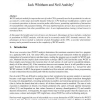Free Online Productivity Tools
i2Speak
i2Symbol
i2OCR
iTex2Img
iWeb2Print
iWeb2Shot
i2Type
iPdf2Split
iPdf2Merge
i2Bopomofo
i2Arabic
i2Style
i2Image
i2PDF
iLatex2Rtf
Sci2ools
WCET
2008
2008
Traces as a Solution to Pessimism and Modeling Costs in WCET Analysis
WCET analysis models for superscalar out-of-order CPUs generally need to be pessimistic in order to account for a wide range of possible dynamic behavior. CPU hardware modifications could be used to constrain operations to known execution paths called traces, permitting exploitation of instruction level parallelism with guaranteed timing. Previous implementations of traces have used microcode to constrain operations, but other possibilities exist. A new implementation strategy (virtual traces) is introduced here. In this paper the benefits and costs of traces are discussed. Advantages of traces include a reduction in pessimism in WCET analysis, with the need to accurately model CPU internals removed. Disadvantages of traces include a reduction of peak throughput of the CPU, a need for deterministic memory and a potential increase in the complexity of WCET models.
| Added | 30 Oct 2010 |
| Updated | 30 Oct 2010 |
| Type | Conference |
| Year | 2008 |
| Where | WCET |
| Authors | Jack Whitham, Neil C. Audsley |
Comments (0)

